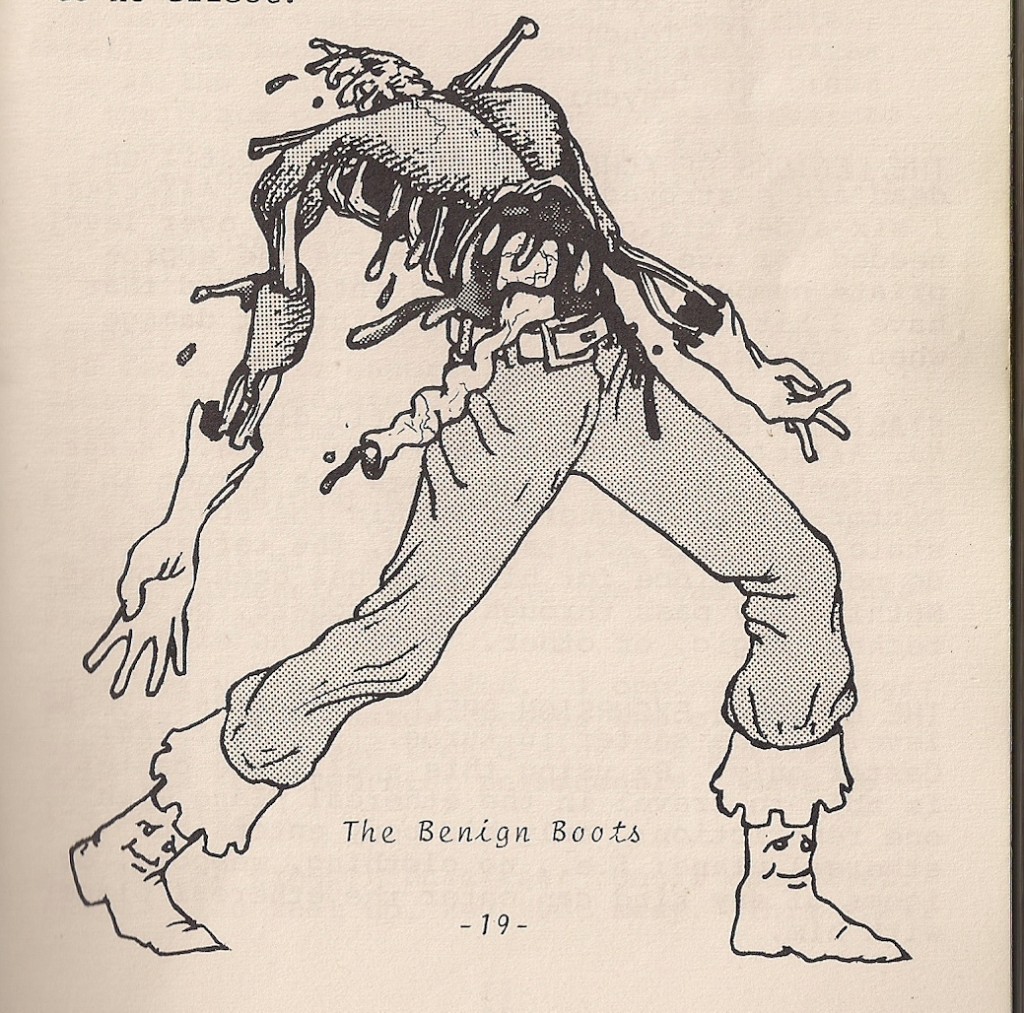Necromican, Level 8 And 9
Necromican, Level 8 And 9
Featuring Benign Boots
Wow. I just checked and realized the last post in this series was written almost a year ago. Fortunately, that wasn’t the last time this site was updated, though it seems that way at times. I’ll try to do better after GenCon. My imaginary audience needs real articles, damn it!
Should I keep y’all in suspense, or should I just jump, right now, to the single best part of this section, and perhaps of the entire book, the illustration for the Benign Boots? Well, unfortunately, I apparently already posted the illustration long before I got here. Also the two articles I mentioned being in progress over a year ago are still in progress. Wow. My laziness astonishes even me.
Ah well, here it is again.
For those just wandering in from some random link, this article is part of a series looking at the wonderful (that should be read, by the way, without sarcasm or irony, because it is wonderful, in every way, full of wonders) classic old-school, and highly unofficial, supplement, “The Necromican” (note spelling, compare to Lovecraft), produced by Fantasy Art Enterprises in 1979. This was one of two such books they produced, which is a deep pity, as they could have gone on to all manner of greatness. The other was the even more astounding and wondrous Booty And The Beasts.
(You can see the first part of the Necromican review here , the second part here, the third part here, the fourth part here, and the fifth part here.)
Variable Shape Fireball
One of the classic problems with “Let’s pretend” games that don’t come with volumes of rules that resemble calculus textbooks crossed with Sports Illustrated’s Chainmail Swimsuit Issue is the constant arguing and fighting. (“Bang bang! I got you!” “Nuh uh, you couldn’t see me!” “Could too!” “Could not!”). In modern games, these kinds of childish disagreements are resolved objectively using cover and concealment rules. (“Hah! I shot the orc!” “No way, you couldn’t see him!” “Could to!” “Oh yeah? Look. The rules say to draw an imaginary line for any three of four corners which bisects the center of the figure…” “Nuh uh, those rules have been errata’d. You draw a line from the center of one square to the center of the other and if it passes through fewer squares than the average of your Wisdom and BAB you can roll 1d4 and count off counter-clockwise (clockwise in Australia) until you…”)
Yeah. Anyway, back in Ye Olden Dayse, one of the biggest sources of Creative and Imaginative Immersive Roleplaying Not Rollplaying was “Arguing over whether or not the stupid magic-user blasted you with his fireball.” This spell in the Necromican settles that, by allowing the M-U to specify any imaginable shape for his fireball… well, fireblob, really, I guess… so long as it remained contiguous, with the specific and explicitly noted purpose of excluding the MU’s friends, which , I feel obliged to note, did not necessarily mean “all members of his party”. (This particular distinction would one day be reborn with D&D 4e and discussions over who counted as an “ally”. Actually, come to think of it, it still shows up in Pathfinder, as I often need to decide if a particularly dubious NPC counts as an “ally” for purposes of buff spells.)
Monster Analyzer
This spell creates a 10 foot long spiked club and shoves it straight up the monster’s… wait… no, I’ve seen too many movies with ‘clever’ titles. This spell analyzes the monster, revealing hit points, AC, immunities, and so on. Again, it’s interesting that we see an example of the repeated pattern of spells substituting for missing non-spell mechanics, in this case, some means to measure character knowledge of monsters. (We had two ways to do it. One, the player memorized the Monster Manual, and/or learned by having various characters die, then, through a sort of Akashic memory, having his next character know what killed his previous character, and, two, the DM ruthlessly snarling at you if you showed knowledge your character didn’t have. I don’t remember ever being told to “roll an intelligence check” to determine if my character knew something.) Anyway, this spell might make a lot of sense, but not as an eighth level spell. Even in munchkin games, you did not have high level memorizations to waste on a spell like this. First or second level, sure. It was probably eighth level because “Try to hit the players with a monster they don’t know everything about” was a big part of the meta-game, which was a lot more competitive back then.
Unrequested Ethereal Ejection
This sounds like something you tell your doctor about in strict confidence, and hope he gives you the pills himself rather than making you bring a prescription to your pharmacist. Casting the spell requires the somatic component “Honest, honey, that’s never happened to me before.” Sigh. Well, actually, it sends the target to the ethereal plane, which means it should be called Unrequested Ethereal Insertion, which I’m pretty sure is a Class-D felony that carries a minimum 5 year penalty. The spell gleefully notes that “none of the victim’s accouterments accompany him, so the target appears on the ethereal plane quite naked.”
Benign Boots
You’ve seen the picture, now read about the spell! This spell creates magic boots around your feet. When you die, the boots transport themselves and the corpse onto the astral plane and then run at triple speed to a predesignated place of safety. I’m not sure how much good this would do if you’ve been disintegrated or had your legs sliced off, but that’s what DMs are for, to make these kinds of judgments without needing mounds of tedious special-case rules, and then listen to the players whine about them. I suspect the main use for this spell was to get your body away from your fellow adventurers before they looted your corpse.
Level 9
Gaze Of Cthulhu
This spell gives you the face of Cthulhu, so, everyone around you passes out with fear and wakes up gibbering. (Save for stun.) It’s not 100% clear if the “wakes up gibbering” is permanent, but it’s strongly implied. Notable mostly for the fact that this book was published two years before Call of Cthulhu really brought Lovecraft’s work front-and-center in the RPG world, and a year before TSR’s Deities and Demigods, which is what introduced most of us ignorant young savages to the Elder Gods. In other words, the Lovecraft references in this and B&TB shows they were ahead of the curve.
Hope
Sadly, there is not a corresponding spell called “Change”. Anyway, this spell is “like the wishes granted by genies”, except, instead of saying “I wish…” you say “I hope…”, and there’s a 50% chance of the spell working. Which might be kind of cool, except that, by the time this book came out, the “Wish” spell, which was also 9th level, had been part of D&D lore for years, appearing in Greyhawk in 1976. There’s no modifiers to the spell that make it superior to Wish, except that Wish will incapacitate you for 2-8 days and this will only do so for 1 day. (So, really, you could play the odds and cast the same Hope every day until you got it. On average, you’ll have less downtime.)
Desolation
This spell kills all non-magical plant life in a one-mile area. The description notes “…this spell would not kill ents, but would destroy the forest they were living in.” Yeah. Yeah. How’d that work out for Saruman? Why not just call this spell “Summon pissed-off trees”?
Perilous Parasite
This is basically a “drain stats” spell, with the nice special effect of creating a parasite inside the victim’s skull and the text notes that said parasite is only detectible by cutting open the victim’s head and looking inside. I’ll take the stat drain, thank you.
Superb Submersible

Ixx-ticks-ack-ittil?
This spell creates a small, magically powered, submarine with a depth ceiling (depth floor?) of 360′ and a duration of four hours, which leads me to wonder how many DMs gleefully sat there while the players dithered and dilly-dallied and counted out their copper pieces before announcing “Spell’s over, you’re 360 feet underwater, and look, here come some Ixit… Ixitch… Ixchitz…. Evil Manta Ray People!”
These guys. Right here. Or, better yet, any of the horrid undersea things from Booty And The Beasts.
Demon Summoning A
This spell summons one of four demons, statted out in the book. The spell lasts 24 hours, and the demon will vanish at the end of said time, whether it completes the task or not. The demon is obliged to try to complete the task, though, not just hang around and wait for the clock to run out. Anyway, what make this spell interesting is that the type of demon you get is random, and the tasks each can perform are not identical. In other words, you might want a demon to do some particular deed, then get one which can’t do it. So, basically, this spell is for people who want to summon a demon and then decide what to accomplish with it. I guess it might make sense to have a list of tasks, at least one of which is suited to each demon you might summon. Oh, one of the demons, the imaginatively named Dark Demon, requires you to sacrifice the soul of a close friend when it is summoned. So, never summon without your buddy! (Also, have a large supply of ‘close friends’. The problem is, as I see it, that the demon requires genuine sacrifice — you really have to like the guy. So this means finding a lot of people you genuinely care about, and somehow managing to keep genuinely caring about them while knowing they’re all potential demon fodder.)
And Onwards
Now, you might think that with ninth level spells done, we’re done, but oh no! This was the late 1970s, an era when everything went up to Eleven…or in the case of the Necromican, up to Twelve. (Twelth level spells, that is!)



You gotta finish this series!
The mere fact someone is reading *anything* I post here is enough inspiration. Consider it my top priority while I wait for final art for Rogue Planet.